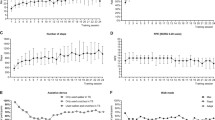Abstract
In 2012 the neurologic controlled exoskeleton Hybrid assistive limb (HAL) was introduced in the spinal cord injury unit of the university hospital Bochum. Until now 20 acute and 40 chronic injured SCI patients (AIS A-D) have been treated for a three-month body weight supported treadmill training paradigm wearing HAL with a daily intervention. Here we report the feasibility, safety and outcome aspects. All subjects improved due to their functional walking abilities without wearing HAL. The training was feasible, safe and suitable in acute and chronic SCI patients. No severe adverse events were recorded.
This trial was partially supported by NEDO (New Energy and Industrial Technology Development Organization, Japan) and the European Union Fond, IuK Gender Med., Nordrhein-Westfalen.
Access this chapter
Tax calculation will be finalised at checkout
Purchases are for personal use only
Similar content being viewed by others
References
M. Aach, R.C. Meindl, J. Geßmann, T.A. Schildhauer, M. Citak, O. Cruciger, Exoskeletons for rehabilitation of patients with spinal cord injuries. Options limitations 118(2), 130–137 (2015). doi:10.1007/s00113-014-2616-1. Unfallchirurg
M. Aach, O. Cruciger, M. Sczesny-Kaiser, O. Höffken, RCh. Meindl, M. Tegenthoff, P. Schwenkreis, Y. Sankai, T.A. Schildhauer, Voluntary driven exoskeleton as a new tool for rehabilitation in chronic spinal cord injury: a pilot study. Spine J. 14(12), 2847–2853 (2014). doi:10.1016/j.spinee.2014.03.042. Epub 2014 Apr 4
Author information
Authors and Affiliations
Corresponding author
Editor information
Editors and Affiliations
Rights and permissions
Copyright information
© 2017 Springer International Publishing AG
About this paper
Cite this paper
Grasmücke, D., Cruciger, O., Meindl, R.C., Schildhauer, T.A., Aach, M. (2017). Experiences in Four Years of HAL Exoskeleton SCI Rehabilitation. In: Ibáñez, J., González-Vargas, J., Azorín, J., Akay, M., Pons, J. (eds) Converging Clinical and Engineering Research on Neurorehabilitation II. Biosystems & Biorobotics, vol 15. Springer, Cham. https://doi.org/10.1007/978-3-319-46669-9_201
Download citation
DOI: https://doi.org/10.1007/978-3-319-46669-9_201
Published:
Publisher Name: Springer, Cham
Print ISBN: 978-3-319-46668-2
Online ISBN: 978-3-319-46669-9
eBook Packages: EngineeringEngineering (R0)




